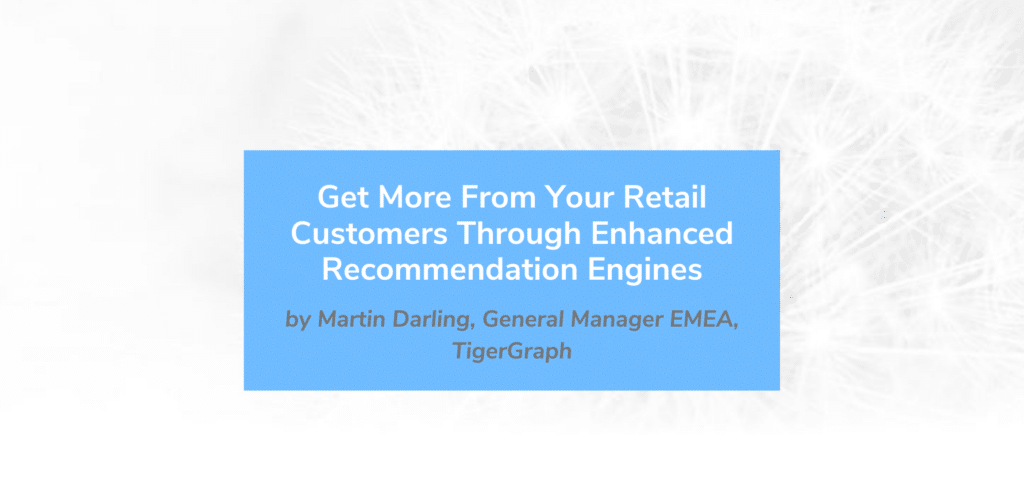Get More From Your Retail Customers Through Enhanced Recommendation Engines
- Blog >
- Get More From Your Retail Customers Through Enhanced Recommendation Engines

Originally posted on The Evolving Enterprise
A Gartner survey found that half of consumers would unsubscribe from company communications due to poor marketing personalisation, while on a more positive note, 82% of consumers admit to having been influenced by a personalised shopping recommendation.
The problem is, personalisation is not easy. Retailers know they have to do it and usually have some systems in place to deliver it, but according to Gartner, 74% of marketing leaders report struggling to scale up their personalisation efforts.

Faced with the need for accuracy, speed and scale, marketing leaders have turned to graph analytics to power up their recommendation engines.
Getting closer to your customers
Graph analytics involves running mathematical algorithms on a graph database. A graph database differs fundamentally from the traditional relational database that we are all familiar with. Rather than storing data in rows, columns and tables, graph databases are built on a network of ‘vertices’ and ‘edges’, with vertices being individual data points and edges being the relationships between them.
Graph databases are widely used in social media. The datapoints are people and the relationships are ‘friends’ or ‘colleagues’. Using this simple model, Facebook and LinkedIn build very accurate representations of social networks and analyse the data to promote further links.
Product recommendation is an ideal use case for graph because it, too, is fundamentally a relationship problem. How is this customer related to this product have they browsed it, bought it or bought similar products? How do they relate to other customers and what have those customers purchased? What is their demographic profile and how are those demographic categories linked to buying behaviour?

Strategies for generating tailored recommendations take many forms, from the simple to the complex, with varying levels of effectiveness:
- Basic recommendation – delivers a set of results based on search terms. This is a search-to-things relationship. E.g., customer searches for “children’s shoes”.
- Content filtering – matches product attributes with customer attributes and the attributes of things they have previously purchased. For instance, based on your previous purchase of X, we think you might like A, B or C. This is a thing-to-thing relationship.
- Collaborative filtering – matches customers with other customers who bought similar products. For instance, people who bought this item also bought this. This is a thing-to-people-to-things relationship.
- Intelligent or hybrid search result – delivers basic search results plus collaborative filtering to prioritise items purchased by similar individuals. This is a search-to-people-to-things relationship.
- Branching hybrid recommendation – after a user selects a product from a list of search results, this delivers related items using content filtering to constrain the list and collaborative filtering to prioritise it. For instance, people who looked at this item also looked at this item. This is a thing-to-thing-to-people-to-things relationship.
More complex variations can be created by chaining these strategies together or adding additional factors such as weather forecasts, upcoming holidays and personal data including birthdays, gender and age.
Each additional step that you add to the chain is known as a ‘hop’. Simple searches involve one or two hops, while the most complex searches can easily increase to 10 or 15 hops. The problem for legacy relational databases is that they struggle to cope with more than two or three hops while native parallel graph databases easily scale to 15 hops or more.
Traditional recommendation engines built on relational databases perform global statistical analysis offline, using snapshots of data that may be days old. But graph databases can perform deep analysis and deliver hyper-personalised results in milliseconds.
Kickdynamic uses graph analytics to supercharge its email marketing platform used by more than 200 leading brands to boost customer engagement and sales.
Using graph, it pulls customer relationship management (CRM) data from multiple sources, connects or hops through more than 10 levels of data and constructs millions of personalised customer emails for its clients based on onsite browsing history, similarities across products and users, and cross-user behavioural patterns.

The ability to process queries in real time allows it to deliver updated pricing and product information at every email opening. Using customer preferences and product availability, it captures key ‘business moments’ and delivers targeted recommendations all in less time than it takes the customer to read the subject line.
The result is increased customer engagement, brand loyalty and sales conversions, according to Kickdynamic’s chief product officer, Gabrielle Corti.
Customers are unique, varied and complex which can be difficult for businesses to understand, especially at scale. But with graph analytics, retailers can convert that weakness into a strength and deliver, on the fly, offers and recommendations that truly speak to them.
Recommendations not only generate more sales but also help retailers build a deeper relationship with their customers by giving them a sense of being understood and properly served.












